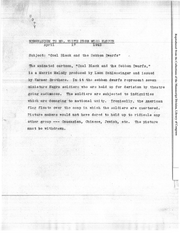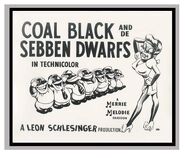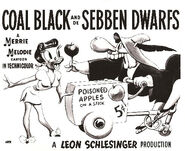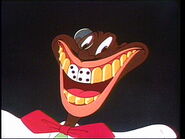Warning! This page contains content that can be seen as mature or inappropriate for younger audiences. Please continue at your own risk.
Coal Black and de Sebben Dwarfs is a 1943 Merrie Melodies short directed by Robert Clampett.
Title[]
The title is spelled in a stereotypical African-American dialect. The intended title was "So White and de Sebben Dwarfs" however, producer Leon Schlesinger thought was too close to the original film's actual title and had it changed to "Coal Black and de Sebben Dwarfs."[6]
Overview[]
In this version of the the Brothers Grimm fairy tale "Snow White", all of the characters are African American, and speak all of their dialogue in rhyme. The story is set during WWII in the United States, and the original story's fairy-tale wholesomeness is replaced in this film by a hot-jazz mentality and sexual overtones. Several scenes unique to Disney's film version of Snow White, such as the wishing-well sequence, the forest full of staring eyes, and the awakening kiss, are directly parodied in this cartoon.
Plot[]
In front of a fireplace is a red-tinted silhouette of a large woman holding a young child in her lap. The little black girl asks her "mammy" to tell her the story of "So White an' de Sebben Dwarfs". "Mammy" begins:
- "Well, once there was a mean ol' queen. And she lived in a gorgeous castle. And was that ole' gal rich! She was just as rich as she was mean! She had everythang!"
The rich, Wicked Queen then appears, depicted as a "food hoarder", with a large repository of items that were on ration during World War II: rubber, sugar, gin ("Eli Whitney's Cotton Gin" brand) and more. After stuffing her face with candies (from a box marked "Chattanooga Chew-Chews"), she asks her magic mirror to "send her a prince 'bout six feet tall", but when Prince Chawmin' arrives in his flashy car, he declares "that mean ol' queen sho' is a fright / but her gal So White is dyn-a-mite!" Finding So White hard at work doing the laundry, the prince takes her hand and the two swing out into a wild jitterbug. The queen sees this and hires "Murder, Incorporated" to "black-out So White." The assassins arrive in a panel truck that advertises, "We rub out anybody for $1.00; Midgets: 1/2-price; Japs: free".
The assassins kidnap the girl, but after several unseen "favors" which make the would-be assassins very happy, set her free in the woods unharmed. Just before they drive off, the assassins are seen covered with So White's lipstick, an innuendo as to exactly how she earned her freedom. Wandering through the woods by herself, So White runs into the Sebben Dwarfs, seven diminutive army men in uniform who sing "We're in the Army Now," with two dwarfs singing "it takes us cats ... to catch those rats" at the end, and So White declares in a 1940s swing-style singing voice, "I'm wacky over khaki now!" They immediately recruit her as their squad cook, and she spends her days "fryin' up eggs an' pork chops too" (to the tune of "Five O'Clock Whistle") for the hungry soldiers, as a sign which hangs from her outdoor antique stove reads, "Keep 'em frying," as a sendup of the World War II slogan, "Keep 'Em Flying."
Meanwhile, the queen has learned that So White is still alive, and pumps an apple full of poison which she wants to give to the girl and kill her. Several worms escape the apple as the queen injects it with poison, one carrying a sign that says "Refoogees." The queen disguises herself as an old peddler woman, and arrives at the Sebben Dwarfs' camp and gives So White the poisoned apple. One of the seven dwarfs (modeled on the "Dopey" dwarf in Disney's film) alerts the others that the queen has caused So White to "kick the bucket," and the entire squad hops into its vehicles (a Jeep, a "Beep," and, for "Dopey," a "Peep"). As the queen makes her escape over the hills, the dwarfs load a cannon with both a war shell and "Dopey." The shell sails over to the queen, stops in front of her in mid-air, opens, and "Dopey" appears, knocking the crone out with a mallet.
Even though the queen has been defeated, So White is still dead to the world. The dwarfs note, in spoken rhyme:
- "She's outta this world! She's stiff as wood!
- She's got it bad, and that ain't good!
- There's only one thing that'll remedy this
- and dat's Prince Chawmin' and his Dynamite Kiss!"
Upon the dwarfs' invoking of his name, the prince jumps into the scene in a spotlight and promises to "give her a kiss / and it won't be a dud / I'll bring her to life with my special 'Rosebud'!". Wiping his lip and leaning over the girl in preparation, Prince Chawmin' proceeds to give So White a succession of highly aerobic kisses, practically swallowing the girl's face whole in trying to awaken her, but without any luck. Prince Chawmin' keeps frantically kissing So White (his efforts underscored by a solo from Eddie Beale's trumpet player), and the efforts literally take the life out of him as he turns into a withered old man, shrugging his shoulders in defeat (although there seems to be an alternate version of this scene, where he just ages and his face turns into a lighter hue). The "Dopey" dwarf then saunters over to So White, and, to the tune of "You're in the Army Now," lays a kiss on the girl so dynamic that not only does So White wake up, but her eyes become large as saucers and her pigtails fly straight up into the air (depicted in Rod Scribner's typically extreme animation style) as she jumps into the air.
The worn-out and aged Prince asks "Dopey," "Man, what you got that makes So White think you so hot?!" "Dopey" replies, "well, dat is a military secret," and lays another kiss on So White, which sends her pigtails sailing into the air again and causes the red ribbons on them to turn into twin American flags, to several notes of "The Stars and Stripes Forever", and immediately after the kiss, So White shows an obvious "afterglow" in her eyes and her smile.
Caricatures[]
- Fats Waller - dwarfs
- Stepin Fetchit - dwarf
- Jimmy Durante- the queen imitates him
- Orson Welles - The prince's lips homaging the opening scene of Citizen Kane when saying "Rosebud".
Music Cues[7][]
- The Gold Diggers' Song [We're in the Money] (by Harry Warren)
- Plays when Tires, Sugar and Coffee are shown
- Blues in the Night (by Harold Arlen & Lyrics by Johnny Mercer)
- Briefly sung by Vivian Dandridge as So White
- Blues in the Night (by Harold Arlen & Lyrics by Johnny Mercer)
- Plays again when So White is in a cave
- You're In The Army Now (by Isham Jones Lyrics by Tell Taylor and Ole Olsen)
- So White and The Dwarfs
- Reveille (traditional)
- (A jazzy-rendition) plays briefly when the sun rises
- Five O'Clock Whistle (by Gene Irwin and Josef Myrow & Lyrics by Kim Gannon)
- Sung with substitute lyrics by Vivian Dandridge as So White. Continues to play throughout the scene
- Dixie (by Daniel Decatur Emmett)
- Plays briefly when the Dwarfs place a missile in the cannon.
- Five O'Clock Whistle (by Gene Irwin and Josef Myrow & Lyrics by Kim Gannon)
- Plays again briefly before the Queen gets struck by one of the Dwarfs
- Blues in the Night (by Harold Arlen & Lyrics by Johnny Mercer)
- Plays again when So White is on the ground
- You're in the Army Now (by Isham Jones Lyrics by Tell Taylor and Ole Olsen)
- Plays when So White comes back to life
- Red, White and Blue (by Thomas A. Beckett)
- Plays at the end
Production[]
- Clampett intended Coal Black as both a parody of "Snow White" and a dedication to the all-black jazz musical films popular in the early 1940s. In fact, the idea to produce Coal Black came to Clampett after he saw Duke Ellington's 1941 musical revue Jump for Joy, and Ellington and the cast suggested Clampett make a black musical cartoon. The Clampett unit made a couple of field trips to Club Alabam, a Los Angeles area black club, to get a feel for the music and the dancing, and Clampett cast popular radio actors as the voices of his main three characters. The main character, So White, is voiced by Vivian Dandridge, sister of Dorothy.
- Two actor's voice the wicked Queen. Danny Webb does his famous "grouchy" voice, whereas Ruby Dandridge, mother of Vivian and Dorothy, performs a much softer voice. Leo "Zoot" Watson is the voice of Prince Chawmin'. The other characters, including the Sebben Dwarfs, are voiced by standard Warner voice artist Mel Blanc.
- Famous jazz musician Louis Armstrong, wanted the role of Prince Chawmin', but was booked on tour.[3]
- Originally, Clampett wanted an all-black band to score the cartoon, the same way Max and Dave Fleischer had Cab Calloway and His Orchestra score the Betty Boop cartoons "Minnie the Moocher", "The Old Man of the Mountain", and their own version of "Snow White". However, Schlesinger refused, and the black band Clampett had hired (Eddie Beals and His Orchestra), only composed and recorded for the final kiss sequence. The rest of the film was scored by Carl Stalling.
Notes[]
- The character designs for So White and her seven friends are examples of the darky iconography typical of Hollywood features and animated shorts during the early 20th century.
- The Prince, a vague Cab Calloway lookalike, is a slender, zoot-suited Black man with straightened hair, a monocle, and gold teeth (with dice in place of the front two incisors). Both he and the dwarfs have large eyes, small noses, and unnaturally large pink lips, derived from the appearance of a white man in blackface rather than that of an actual black man.
- The middle-aged wicked Queen is an overweight, asexual crone, with large lips that are only partially covered with lipstick (the Queen's lipstick only extends as far as it would if her lips were proportionate to her face).
- Only So White escapes the extreme caricature given the other characters, although she is stereotyped in a different manner. She is an attractive young woman with a voluptuous figure revealed by a short skirt and a low-cut, cleavage-revealing blouse. This references Walter Lantz's 1941 cartoon Scrub Me Mama with a Boogie Beat, where a young light-skinned Black woman is depicted as attractive while the other Black characters are drawn as extreme caricatures. In both that film and Coal Black, the sexually-attractive features of the young women are significant plot devices. In Coal Black, So White is the object of sexual desire for every male character in the picture. This draws upon the stereotype of the young attractive black woman as an "exotic" sexual being, a stereotype present in roles that African-American actresses such as Dorothy Dandridge and Lena Horne played in American cinema.
- Because it was produced in America during World War II, there is also anti-Japanese sentiment: the firm "Murder Inc." advertises that it does not charge to kill "Japs".
- Clampett would revisit black jazz culture again in another 1943 Merrie Melodies cartoon "Tin Pan Alley Cats", which features a feline caricature of Fats Waller in a repurposing of the wacky fantasy world from "Porky in Wackyland" (during the opening sequence, the "Fats" cat is distracted by what appears to be a sexy, feline version of So White). Clampett's colleague Friz Freleng directed a cartoon titled "Goldilocks and the Jivin' Bears" in 1944, essentially Coal Black remade with a different fairy tale, and Warner's director Chuck Jones directed a series of shorts starring a prepubescent African hunter named Inki from 1939 to 1950. Like Coal Black, "Tin Pan Alley Cats" and "Goldilocks and the Jivin' Bears" would also end up in the Censored Eleven.
- This short appeared briefly in the 1989 Turner Entertainment VHS release Cartoons for Big Kids, hosted by Leonard Maltin, and in the Behind the Tunes featurette, Once Upon a Looney Tune in the Looney Tunes Golden Collection: Volume 5 DVD box set.
- On 24 April 2010, Coal Black and De Sebben Dwarfs, along with seven other titles from the Censored Eleven, was screened at the first annual TCM Film Festival as part of a special presentation hosted by film historian Donald Bogle. According to Bogle, the eight shorts shown were restored from their original negatives for that release. These restored copies have not been seen since and the future Censored Eleven DVD has been delayed indefinitely, with marketers citing to a lack of Looney Tunes cartoon sales from the Warner Archives.
- This cartoon was shown in theatres with "The Gorilla Man" during its original release.
- On a model sheet, the Queen is given the name "Queenie".
- Vitaphone release number: 1093[8]
Reception[]

- In January 1943, the film press greeted the cartoon with glowing reviews, and no mention of stereotype or offense. Motion Picture Exhibitor said, "A satire on Snow White done in blackface, set in modern swing, this is the best in a long time. It's very funny." The Film Daily agreed, saying, "Set this one down as a rather amusing satire on Snow White and the Seven Dwarfs. All the characters in the latter are replaced by darkies... The dwarfs come to the rescue in a way that makes for numerous laughs."[9]
- In April 1943, the NAACP protested the caricatures which appeared in Coal Black and de Sebben Dwarfs, and called on Warner to withdraw it.

- This cartoon is often praised and defended by film scholars, animation historians and classic animation fans and has often been included on lists of the greatest animated films ever made. One such list, the subject of Jerry Beck's 1994 book "The 50 Greatest Cartoons" placed Coal Black at number twenty-one, based upon votes from over a thousand members of the American animation industry. Scholarly animation texts including Michael Barrier's Hollywood Cartoons: American Animation in Its Golden Age, name Coal Black as Clampett's undisputed masterpiece. Despite being banned, Coal Black is a popular draw at film festivals and small-audience screenings, and is often bootlegged for release on home video.
- Veteran African-American animator and cartoonist Floyd Norman stated/wrote while answering some fans' questions in 2019 that although "considered 'racist' today, Coal Black and de Sebben Dwarfs is an animation masterpiece, and meant no offense to anyone. Clampett was given a standing ovation by a predominantly Black audience in the city of Oakland".[10]
- Otherwise, contemporary audiences see this cartoon in a negative light. With the popularity of video-sharing websites such as YouTube, Coal Black has gained notoriety in recent years for how insensitive it is toward African-Americans. However, most of these videos often put this and other cartoons like it completely out of context, giving no insight of the time of the cartoon's production, instead viewing it with modern sensibilities. Much of these videos are in the controversial "react" variety.
Gallery[]
References[]
- ↑ https://www.facebook.com/photo/?fbid=10165808603900578&set=pb.619090577.-2207520000
- ↑ Catalog of Copyright Entries
- ↑ 3.0 3.1 https://cartoonresearch.com/index.php/animation-anecdotes-190/
- ↑ https://cartoonresearch.com/index.php/jim-korkis-on-bob-clampetts-coal-black-and-de-sebben-dwarfs-1943/
- ↑ https://www.newsfromme.com/2005/04/09/gene-hazelton-r-i-p/
- ↑ https://cartoonresearch.com/index.php/jim-korkis-on-bob-clampetts-coal-black-and-de-sebben-dwarfs-1943/
- ↑ https://www.imdb.com/title/tt0035743/soundtrack/
- ↑ Liebman, Roy (2003). Vitaphone Films: A Catalogue of the Features and Shorts. McFarland, page 277. ISBN 978-0786412792.
- ↑ Sampson, Henry T. (1998). That's Enough, Folks: Black Images in Animated Cartoons, 1900-1960. Scarecrow Press. p. 164. ISBN 978-0810832503.
- ↑ https://web.archive.org/web/20200629121250/https://floydnormancom.squarespace.com/blog/2019/4/27/black-crows-and-other-pc-nonsense
Further Reading[]
- "History Of The 50 Greatest Cartoons of All Time".
- Barrier, Michael (1999). Hollywood Cartoons: American Animation in Its Golden Age. Oxford: Oxford University Press. 0-19-516729-5.
- Beck, Jerry (1994). The 50 Greatest Cartoons: As Selected by 1000 Animation Professionals. Atlanta: Turner Publishing. 1-878685-49-X.
- Goodman, Martin (1998). "Blacker Than Coal?" The Doctor Is In. The Animation Nerd's Paradise. http://anp.awn.com/dr-in-498.html. Retrieved 2007-07-25.
- Klein, Norman M. (1993). Seven Minutes: The Life and Death of the American Animated Cartoon. New York: Verso. pp. 186–199 (chapter on Coal Black). ISBN 0-86091-396-1.
External Links[]
- Coal Black and de Sebben Dwarfs at the Big Cartoon DataBase
- Coal Black and De Sebben Dwarfs at Dailymotion
- Milt Gray on Coal Black
- Debate over Coal Black










